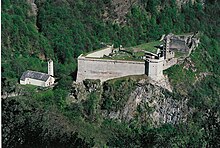Moesa Region
Moesa Region
Regione Moesa (Italian) | |
|---|---|
District | |
 | |
| Country | |
| Canton | |
| Area | |
| • Total | 473.74 km2 (182.91 sq mi) |
| Population (2020) | |
| • Total | 8,770 |
| • Density | 19/km2 (48/sq mi) |
| Time zone | UTC+1 (CET) |
| • Summer (DST) | UTC+2 (CEST) |
| Municipalities | 12 |
The Moesa Region is one of the eleven administrative districts in the Canton of the Grisons (or in German: Graubünden) in Switzerland. It had an area of 473.74 square kilometers (182.91 sq mi) and a population of 8,770 (as of 31 December 2020).[1]. It was created on 1 January 2017 as part of a reorganization of the Canton.[2]
| Municipality | Population (31 December 2020)[1] |
Area (km2)[3] |
|---|---|---|
| Buseno | 91 | 11.15 |
| Castaneda | 278 | 3.96 |
| Rossa | 151 | 58.89 |
| Santa Maria in Calanca | 115 | 9.31 |
| Lostallo | 840 | 50.86 |
| Mesocco | 1,323 | 164.77 |
| Soazza | 324 | 46.42 |
| Cama | 589 | 15 |
| Grono | 1,397 | 37.12 |
| Roveredo (GR) | 2,597 | 38.79 |
| San Vittore | 864 | 22.06 |
| Calanca | 201 | 37.72 |
The region borders with the Viamala Region to the north, with Italy to the east (Lombardy: Province of Sondrio and of Como) and with the Canton of Ticino (districts of Bellinzona to the southwest, Riviera and Blenio) to the west.
Politics
[edit]Administrative division
[edit]



The Moesa region is divided into 12 municipalities:
| Emblem | Name of the municipality | Inhabitants 31 December 2,020 |
Surface in km2 |
|---|---|---|---|
| Buseno | 91 | 11.15 | |
| Calanca | 201 | 37.72 | |
| Cama | 589 | 15.00 | |
| Castaneda | 278 | 3.96 | |
| Grono | 1340 | 36.41 | |
| Lostallo | 840 | 50.86 | |
| Mesocco | 1,323 | 164.76 | |
| Rossa | 151 | 58.88 | |
| Roveredo | 2,597 | 38.79 | |
| Santa Maria in Calanca | 115 | 9.31 | |
| San Vittore | 864 | 22.06 | |
| Soazza | 324 | 46.42 |
Demography
[edit]The Moesa region has about 8500 inhabitants, mostly Italian-speaking, and is part of Italian-speaking Graubünden and Italian-speaking Switzerland.[4] It is linked economically to the Canton of Ticino; linguistically, however, a Lombard Alpine dialect is spoken that is heavily influenced by Germanic terms.
References
[edit]- ^ a b "Ständige und nichtständige Wohnbevölkerung nach institutionellen Gliederungen, Geburtsort und Staatsangehörigkeit". bfs.admin.ch (in German). Swiss Federal Statistical Office - STAT-TAB. 31 December 2020. Retrieved 21 September 2021.
- ^ Swiss Federal Statistical Office - Amtliches Gemeindeverzeichnis der Schweiz - Mutationsmeldungen 2016 accessed 16 February 2017
- ^ Arealstatistik Standard - Gemeindedaten nach 4 Hauptbereichen
- ^ Partners, Degregori & (2016-05-07). Guida ai Paradisi Fiscali (in Italian). R.E.I. Editions. ISBN 978-2-37297-284-0.
